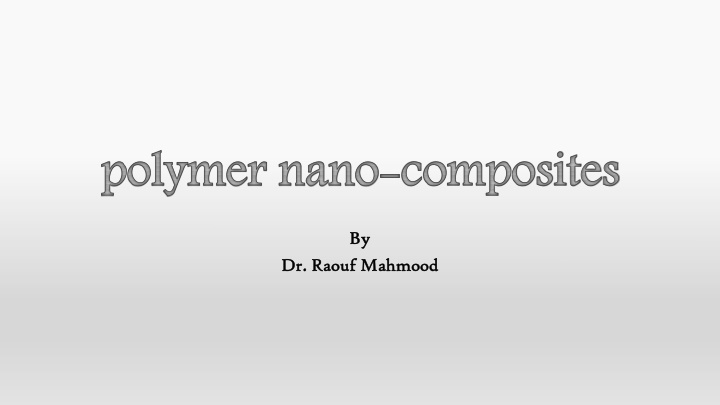
Enhanced Performance with Polymer Nanocomposites by Dr. Raouf Mahmood
Discover the synthesis and benefits of polymer nanocomposites, where inorganic particles are dispersed in an organic polymer matrix to elevate properties such as stiffness, strength, and dimensional stability. Explore applications and advancements in this field for improved materials in various industries.
Download Presentation

Please find below an Image/Link to download the presentation.
The content on the website is provided AS IS for your information and personal use only. It may not be sold, licensed, or shared on other websites without obtaining consent from the author. If you encounter any issues during the download, it is possible that the publisher has removed the file from their server.
You are allowed to download the files provided on this website for personal or commercial use, subject to the condition that they are used lawfully. All files are the property of their respective owners.
The content on the website is provided AS IS for your information and personal use only. It may not be sold, licensed, or shared on other websites without obtaining consent from the author.
E N D
Presentation Transcript
polymer nano polymer nano- -composites composites By By Dr. Raouf Mahmood Dr. Raouf Mahmood
Introduction Introduction The synthesis of polymer nanocomposites is an essential part of polymer nanotechnology. By inserting the nanometric inorganic compounds, the properties of polymers improve and hence this has a lot of applications depending upon the inorganic material present in the polymers. Solvent casting is one of the easiest and less time consuming methods for the synthesis of polymer nanocomposites.
Introduction Introduction Polymer nanocomposites are materials in which nano-scopic inorganic particles, typically 10-100 A in at least one dimension, are dispersed in an organic polymer matrix in order to improve the performance properties of the polymer. Systems in which the inorganic particles are the individual layers of a lamellar compound - most typically a nanocomposites of a polymer (such as nylon) embedded among layers of silicates - exhibit suddenly different physical properties relative to the original polymer. For instance, the layer orientation, polymer-silicate nanocomposites exhibit stiffness, strength and dimensional stability in two dimensions (rather than one). Due to nanometer length scale which minimizes scattering of light, nanocomposites are usually transparent.
Introduction Introduction Polymer nanocomposites represent a new alternative to typical filled polymers. Because of their nanometer sizes, filler dispersion nanocomposites exhibit significantly improved properties when compared to the pure polymers or their traditional composites. These include increased modulus and strength, outstanding barrier properties, improved solvent and heat resistance and decreased flammability.
Introduction Introduction Polymers that contain transition metal complexes ( consist of 3d elements from Sc to Cu, 4d elements from Y to Ag). These macromolecules are hybrid of n-conjugated organic and transition metal containing polymers. n-conjugated organic polymers, such as polyacetylene, poly thiophene, and polypyrrole, as well as oligomers and derivatives of these materials have been extensively explored. These materials are gifted with many important properties such as nonlinear optical properties, luminescence, and have been proposed for their use in various applications including chemical sensors, electroluminescent devices, electro catalysis, batteries, smart windows and memory devices. electronic conductivity and
Introduction Introduction Layered silicate/polymer nanocomposites exhibit superior mechanical characteristics (e.g. 40% increase of room temperature tensile strength), heat resistance (e.g. 100% increase in the heat distortion temperature) and chemical resistance compared to the neat or traditionally filled resins. These property improvements result from only a 0.1-10 vol. % addition of the dispersed Nano phase.
Introduction Introduction Structural applications, polymer nanoparticle compounds have very interesting functional applications. For instance, -Fe2O3/ polymer nanocomposites are used as advanced toner materials for high quality colour copiers and printers. Polymer materials have been filled with several inorganic compounds in order to increase properties like heat resistance, mechanical strength and impact resistance and to decrease other properties like electrical conductivity, dielectric constant thereby increasing the permeability for gases like oxygen and water vapour.
Introduction Introduction Polymer composites containing ferrites are gradually replacing conventional ceramic magnetic materials because of their mould ability and reduction in cost. They are also potential materials for microwave absorbers, sensors and other aerospace applications. These flexible magnets or rubber ferrite composites are possible by the incorporation of magnetic powders in various elastomer matrices. This modifies the physical properties of the polymer matrix considerably.
Characterization Characterization Characterization is an essential part of all investigations dealing with materials. The important features of characterization are chemical composition and compositional homogeneity (chemical homogeneity), structure (including crystal system where possible atomic coordinates, bonding and ultra structure) and identification and analysis of defects and impurities influencing the properties of the materials. Characterization, therefore, describes all those features of composition and structure of a material that would suffice for reproducing the material.
Characterization Characterization The advances made in the last few years in characterization techniques, especially in the structure clarification, have been amazing and have opened new views in solid state materials. Among the several characterization techniques, X-ray diffraction (XRD), scanning electron micrography (SEM) and infrared (IR) spectroscopy are the three important techniques.








